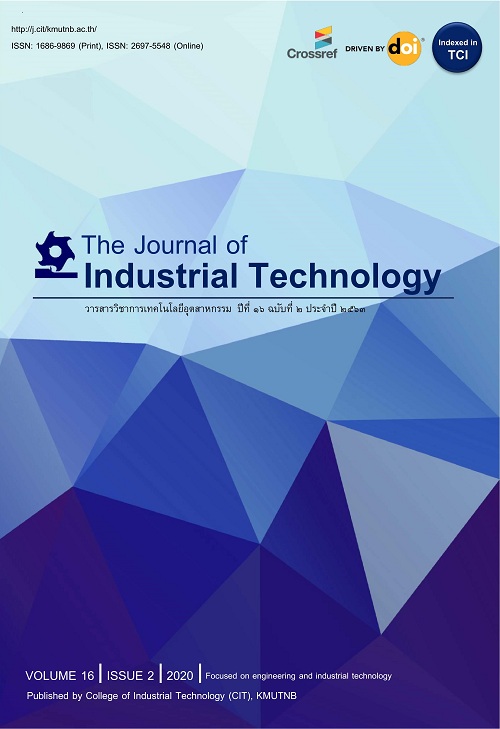Effect of Glass Fiber and Municipal Solid Waste Incineration on Bending Stress of Compacted Cement Sand
อิทธิพลของเส้นใยแก้วและของเสียจากโรงไฟฟ้าเชื้อเพลิงขยะมูลฝอย
Abstract
บทความนี้ศึกษาอิทธิพลของเส้นใยแก้วและของเสียจากโรงไฟฟ้าเชื้อเพลิงขยะมูลฝอยชุมชนต่อกำลังดัดของทรายซีเมนต์บดอัด เพื่อลดปริมาณซีเมนต์และนำของเสียจากจากโรงไฟฟ้าเชื้อเพลิงขยะมูลฝอยชุมชนมาใช้สำหรับพัฒนาวัสดุก่อสร้างที่เป็นมิตรต่อสิ่งแวดล้อม โดยใช้เถ้าลอยและเถ้าจมเป็นส่วนผสมทำการทดสอบกำลังดัดตามมาตรฐาน ASTM C1609-10 ทรายซีเมนต์บดอัดผสมปูนซีเมนต์ร้อยละ 3, 5 และ 7 โดยน้ำหนักทรายแห้ง ผสมเส้นใยแก้วร้อยละ 0, 0.5, 1, 1.5 และ 2 โดยปริมาตร ใช้ความยาวของเส้นใยแก้วที่ 3, 6 และ 12 มิลลิเมตร สัดส่วนเถ้าลอย:เถ้าจมที่ 100:0, 75:25, 50:50, 25:75 และ 0:100 ทำการบ่มที่ 7, 14, 28, 60 และ 90 วัน ผลการทดสอบพบว่ากำลังดัดเพิ่มขึ้นตามปริมาณปูนซีเมนต์ที่เพิ่มขึ้น แสดงปริมาณปูนซีเมนต์มีผลต่อกำลังดัดของเมทริกซ์ โดยปริมาตรปูนซีเมนต์ที่เหมาะสมที่ร้อยละ 5 ความเหนียวที่ระยะแอ่นตัวของทรายซีเมนต์แปรผันโดยตรงกับปริมาณปูนซีเมนต์ที่เพิ่มขึ้น ปริมาณเส้นใยแก้วที่ร้อยละ 1.0 ถึง 1.5 เป็นสัดส่วนที่เหมาะสม ซึ่ง DI และ PSR เป็น 1 แสดงพฤติกรรมการแอ่นแบบวัสดุอ่อน ความยาวของเส้นใยแก้วแปรผันโดยตรงต่อระยะการแอ่นตัวซึ่งความยาวของเส้นใยแก้วที่เหมาะสมคือ 12 มิลลิเมตร ปริมาณเถ้าลอยทดแทนปูนซีเมนต์อยู่ระหว่างร้อยละ 10 ถึง 15 ปริมาณสัดส่วนเถ้าลอย:เถ้าจมที่เหมาะสมคือ 25:75 และพบว่าที่บ่ม 90 วันมีค่าความเหนียวสูงที่สุด
This research article studies on the effect of glass fiber and municipal solid waste from the RDF power plant to bending stress of compacted cement sand to reduce cement and municipal solid waste for development of the green construction materials. Fly ash (FA) and Bottom ash (BA) are mixed into the compacted cement sand and tested according to ASTM C1609-10 standard. Samples are prepared by adding the cement content between 3%, 5% and 7% by weight. The glass fiber is mixed at 0%, 0.5%, 1%, 1.5% and 2% by volume. The glass fiber lengths are 3, 6 and 12 mm. The FA:BA ratios are 100:0, 75:25, 50:50, 25:75 and 0:100. The curing times are 7, 14, 28, 60 and 90 days. It was found that bending stress is increased with increasing the cement content, that is direct proportion to the bending stress of the matrix. The optimum cement content is 5%. The toughness is in direct proportion to the cement content. The glass fiber content is optimum at 1% to 1.5%. The DI and PSR are 1, showing that the softening behavior. The glass fiber length is recommended at 12 mm. The FA content is optimum of about 10% to 15%. The FA:BA ratio is recommended at 25:75. The curing time is recommended at 90 days.
Keywords
[1] A. Dubey, S. Gangopadhyay and W. Wadhwa, Occupational structure and incidence of poverty in Indian towns of different sizes, Review of Development Economics, 2001, 5, 49-59.
[2] T. Sadashivam and S. Tabassu, Trends of urbanization in India: Issues and challenges in the 21st century”, International Journal of Information Research and Review, 2016, 3, 2375-2384.
[3] H. Lu, C. Wang, Q. Li, R. Wiser and K. Porter, Reducing wind power curtailment in China: Comparing the roles of coal power flexibility and improved dispatch, Climate Policy, 2019, 19, 623-635.
[4] C.Y. Lin and T.A. Chen, Effects of composition type and activator on fly ash-based alkali activated materials, Polymers, 2021, 14, 63.
[5] A. Petcherdchoo, S. Pochalard and K. Piriyakul, Use of bender element tests for determining shear modulus of fly-ash and cement admixed Bangkok clay with considering unconfined compressive strength, Case Studies in Construction Materials, 2023, 18, 1-13.
[6] https://thaimsw.pcd.go.th/report1.php?year=2565.(Accessed on 30 August 2024)
[7] H.L. Dinh, J. Liu, D.E. Ong and J.H. Doh, A Sustainable solution to excessive river sand mining by utilizing by-products in concrete manufacturing: A state-of-the-art review, Cleaner Materials, 2022, 6, 1-85.
[8] https://civiltoday.com/civil-engineering-materials/concrete/270-concrete-definition-components-types. (Accessed on 30 August 2024)
[9] M.W.M. Abdias, M.M. Blanche, U.J.P. Nana, H.F. Abanda, N. François, and P. Chrispin, River sand characterization for Its use in concrete: A revue, Open Journal of Civil Engineering, 2023, 13, 353-366.
[10] X. Yang, S. Liang, Z. Hou, D. Feng, Y. Xiao and S. Zhou, Experimental study on strength of polypropylene fiber reinforced cemented silt soil, Applied Sciences, 2022, 12, 8318.
[11] C. Tang, B. Shi, W. Gao, F. Chen and Y. Cai, Strength and mechanical behavior of short polypropylene fiber reinforced and cement stabilized clayey soil, Geotextiles and Geomembranes, 2007, 25, 194-202.
[12] P. Jamsawang, P. Voottipruex and S. Horpibulsuk, Flexural strength characteristics of compacted cement-polypropylene fiber sand, Journal of Materials in Civil Engineering, 2014, 27(9), 04014243.
[13] J. Hu, Z. Ge and K. Wang, Influence of cement fineness and water-to-cement ratio on mortar early-age heat of hydration and set times”, Construction and building materials, 2014, 50, 657-663.
[14] P. Jamsawang, P. Voottipruex, and S. Inthapichai, Improvement of the bending stress of polypropylene fiber-reinforced compacted cement sand”, The Journal of King Mongkut's University of Technology North Bangkok, 2014, 24, 43-55.
[15] S. Pochalard, C. Wungsumpow and K. Piriyakul, Enhancement on compressive strength of Bangkok clay cement using novel high-strength polyethylene fibers, IOP Conference Series: Earth and Environmental Science, 2024, 1-8.
DOI: 10.14416/j.ind.tech.2024.12.014
Refbacks
- There are currently no refbacks.






